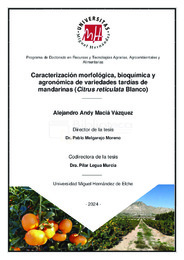Por favor, use este identificador para citar o enlazar este ítem:
https://hdl.handle.net/11000/35691Caracterización morfológica, bioquímica y agronómica de variedades tardías de mandarinas (Citrus reticulata Blanco)
| Título : Caracterización morfológica, bioquímica y agronómica de variedades tardías de mandarinas (Citrus reticulata Blanco) |
| Autor : Maciá Vázquez, Alejandro Andy |
| Tutor: Melgarejo Moreno, Pablo Legua, Pilar |
| Editor : Universidad Miguel Hernández |
| Departamento: Departamentos de la UMH::Producción Vegetal y Microbiología |
| Fecha de publicación: 2024-11-08 |
| URI : https://hdl.handle.net/11000/35691 |
| Resumen : Las mandarinas son uno de los cítricos más importantes en cuanto a producción y exportaciones a nivel mundial. Existen una amplia variedad de mandarinas comerciales, pero de las más destacadas son las recolectadas en la época invernal, las variedades tardías. Estas tienen un alto valor económico, por tener altos rendimientos de producción de frutos, por recolectarse en una época en la que existen pocas variedades comerciales y por estar sometidas a estrictas limitaciones de cultivo por los obtentores. Por ello, el análisis detallado de las variedades comerciales tardías, el efecto que tiene el portainjerto en la calidad final del fruto y la adaptación de los árboles a las condiciones bióticas y abióticas cada vez más extremas por el cambio climático, son de gran interés para la agricultura. Con todo esto, el objetivo de esta Tesis Doctoral es caracterizar morfológica, bioquímica y agronómicamente tres variedades tardías de mandarinas (Citrus reticulata Blanco) en condiciones homogéneas de cultivo. Específicamente se caracterizaron y compararon los frutos de las variedades tardías ‘Afourer’, ‘Orri’ y ‘Tango’, se analizó la influencia del portainjerto en los frutos de variedades tardías de mandarinas, y se analizaron los metabolitos presentes en las hojas de las variedades tardías ‘Afourer’, ‘Orri’ y ‘Tango’ y su influencia en las características agronómicas. Los resultados de la caracterización de estas variedades tardías mostraron que la variedad 'Afourer' destacó por tener un 20% más de tamaño y peso en comparación con las otras variedades. La variedad 'Orri' destacó por tener una gran cantidad de zumo y un mayor brillo, así como una concentración de azúcares un 18% mayor, además de mostrar una mayor cantidad de ácido málico en comparación con el ácido cítrico. Las mandarinas 'Tango' injertadas sobre Forner Alcaide nº5 presentaron un mayor peso y tamaño, así como una tonalidad más anaranjada y una mayor cantidad de fenoles totales. El análisis metabolómico reveló que todas las muestras de mandarina analizadas contenían predominantemente aminoácidos no esenciales. Los portainjertos mandarino Cleopatra y Citrange Carrizo fueron los más interesantes en función del conjunto de características morfológicas, bioquímicas y sensoriales, destacando por la producción de frutas de mayor tamaño, mejor rendimiento en zumo, y una mayor calidad organoléptica. El análisis de los metabolitos en las hojas mostró que la variedad 'Afourer' destaca, desde el punto de vista agronómico, por su mayor crecimiento vegetativo. Por otro lado, la variedad 'Tango' mostró una mayor resistencia al estrés abiótico. No obstante, la variedad 'Orri' sobresalió sobre las otras dos por su resistencia tanto a estreses abióticos como bióticos, y por producir frutos más dulces y de mayor calidad, a pesar de tener un menor crecimiento vegetativo Mandarins are among the most significant citrus fruits in terms of production and exports worldwide. There is a diverse range of commercial mandarins, but the most notable are those harvested during the winter season, the late varieties. These have a high economic value due to their high fruit yields, their harvesting at a time when there are few commercial varieties, and their subjection to strict cultivation limitations by breeders. Consequently, the detailed analysis of late commercial varieties, the effect of rootstock on final fruit quality, and the adaptation of trees to increasingly extreme biotic and abiotic conditions due to climate change are of great interest to agriculture. The objective of this PhD Thesis is to characterize morphologically, biochemically, and agronomically three late varieties of mandarin (Citrus reticulata Blanco) under homogeneous growing conditions. Specifically, the fruits of the late varieties 'Afourer', 'Orri' and 'Tango' were characterized and compared, the influence of the rootstock on the fruits of late mandarin varieties was analyzed, and the metabolites present in the leaves of the late varieties 'Afourer', 'Orri' and 'Tango' were analyzed and their influence on the agronomic characteristics was determined. The results of the characterization of three late varieties revealed that the 'Afourer' variety exhibited the greatest size and weight, with an average of 20% greater than the other varieties. The 'Orri' variety exhibited a higher juice quantity and brightness, as well as an 18% higher sugar concentration, and a higher malic acid to citric acid ratio. The 'Tango' mandarins grafted on Forner Alcaide nº5 exhibited greater weight and size, as well as a more orange hue and a higher amount of total phenols. Metabolomic analysis revealed that all mandarin samples analyzed contained predominantly non-essential amino acids. The rootstocks Cleopatra mandarin and Carrizo citrange exhibited the most notable morphological, biochemical, and sensory characteristics. These rootstocks were associated with the production of larger fruits, higher juice yield, and superior organoleptic quality. The analysis of metabolites in the leaves revealed that the 'Afourer' variety exhibited greater vegetative growth, from an agronomic perspective, in comparison to the other varieties. In contrast, the 'Tango' variety demonstrated enhanced resilience to abiotic stress. Nevertheless, the variety 'Orri' exhibited the most notable resistance to both abiotic and biotic stresses, as well as the highest quality fruit, despite displaying the lowest vegetative growth |
| Notas: Programa de Doctorado en Recursos y Tecnologías Agrarias, Agroambientales y Alimentarias |
| Palabras clave/Materias: Mandarinas Morfología vegetal Bioquímica vegetal |
| Tipo de documento : info:eu-repo/semantics/doctoralThesis |
| Derechos de acceso: info:eu-repo/semantics/openAccess Attribution-NonCommercial-NoDerivatives 4.0 Internacional |
| Aparece en las colecciones: Tesis doctorales - Ciencias e Ingenierías |
 La licencia se describe como: Atribución-NonComercial-NoDerivada 4.0 Internacional.
La licencia se describe como: Atribución-NonComercial-NoDerivada 4.0 Internacional.
.png)
